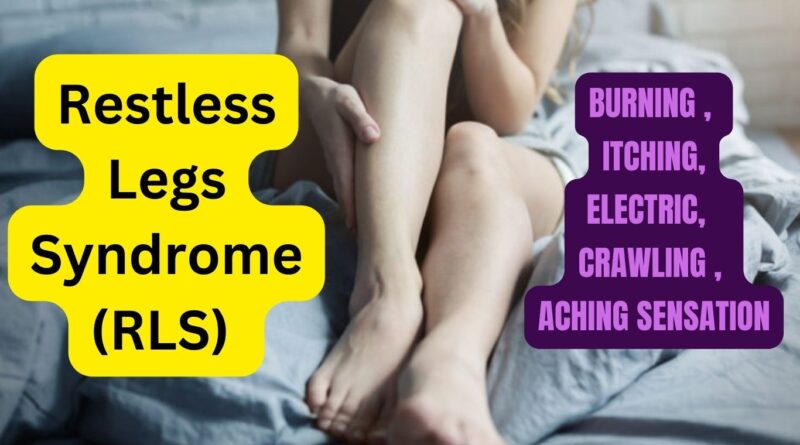Restless Legs Syndrome | Everything you need to know
In my daily practice I get lot of patients who complain about the leg cramps and pain mostly in summer season. Mostly it goes away with magnesium and potassium supplements. But there is a disease which we need to diagnose in most of patient and which is missed by most of the clinicians i.e., Restless Legs Syndrome
Restless Legs Syndrome (RLS) is a neurological disorder characterized by an uncontrollable urge to move the legs, usually accompanied by uncomfortable or unpleasant sensations. It affects people of all ages and can significantly impact their quality of life. In this article, we will explore the symptoms, diagnosis, treatment options, and management strategies for Restless Legs Syndrome.
Understanding Restless Legs Syndrome (RLS)
Definition and Overview
Restless Legs Syndrome, also known as Willis-Ekbom Disease, is a condition that causes an irresistible urge to move the legs, typically due to discomfort or abnormal sensations. The urge is often worse during periods of rest or inactivity and tends to improve with movement. RLS can lead to significant sleep disturbances and daytime fatigue, affecting both physical and mental well-being.
Prevalence and Causes
RLS affects a substantial number of individuals worldwide, with estimates suggesting a prevalence of 5-15% in the general population. The exact cause of RLS is still unknown, but research suggests a combination of genetic and environmental factors. Iron deficiency, certain medications, chronic diseases (such as kidney failure), and pregnancy can also contribute to the development or exacerbation of RLS symptoms.
Symptoms of Restless Legs Syndrome
Primary Symptoms
The primary symptoms of Restless Legs Syndrome include:
- Unpleasant sensations in the legs: Individuals with RLS often describe the sensations as creeping, crawling, tingling, itching, or burning. These sensations may also occur in the arms, but the legs are most commonly affected.
- Urge to move the legs: The uncomfortable sensations lead to an irresistible urge to move the legs to find relief. Movement, such as walking or stretching, temporarily alleviates the discomfort.
- Symptoms worse at rest: Rest triggers or exacerbates RLS symptoms. They are typically more severe in the evening or at night, which can significantly disrupt sleep.
Secondary Symptoms
In addition to the primary symptoms, individuals with Restless Legs Syndrome may experience secondary symptoms, which include:
- Fragmented sleep and insomnia
- Daytime fatigue and sleepiness
- Impaired concentration and memory difficulties
- Mood disturbances, such as anxiety or depression

Diagnosing Restless Legs Syndrome
Diagnosing Restless Legs Syndrome involves a comprehensive evaluation that includes:
- Medical History and Physical Examination: The healthcare provider will review the individual’s medical history and conduct a physical examination to assess for any underlying conditions or potential causes of RLS symptoms.
- Diagnostic Criteria: The International Restless Legs Syndrome Study Group has established four essential criteria for diagnosing RLS. These criteria include the presence of uncomfortable or unpleasant sensations in the legs, the urge to move the legs, symptoms worsening at rest, and symptoms being relieved by movement.
Treatment Options for Restless Legs Syndrome
Lifestyle Changes
Making certain lifestyle modifications can help manage Restless Legs Syndrome. These include:
- Regular exercise: Engaging in moderate exercise, such as walking or swimming, can reduce RLS symptoms and promote better sleep.
- Stretching and leg massages: Stretching the legs and receiving massages may provide temporary relief from discomfort.
- Warm or cold packs: Applying warm or cold packs to the legs can help alleviate symptoms for some individuals.
- Establishing a sleep routine: Maintaining a consistent sleep schedule and creating a relaxing bedtime routine can improve sleep quality.
Medications
In more severe cases or when lifestyle changes alone are insufficient, healthcare providers may prescribe medications to manage RLS symptoms. These may include:
- Dopaminergic agents: Medications that increase dopamine levels in the brain, such as pramipexole or ropinirole, can help reduce RLS symptoms.
- Benzodiazepines: These medications may be prescribed to promote better sleep and relaxation.
- Opioids: In certain cases, opioids may be considered for individuals with severe symptoms.
Other Therapies
Several other therapies may complement the treatment of Restless Legs Syndrome. These include:
- Iron supplementation: If blood tests reveal iron deficiency, iron supplements may be recommended to improve symptoms.
- Transcutaneous electrical nerve stimulation (TENS): TENS therapy involves applying low-voltage electrical currents to the legs, which may help relieve RLS symptoms.
- Cognitive-behavioral therapy (CBT): CBT techniques, such as relaxation exercises and cognitive restructuring, can assist individuals in managing the emotional impact of RLS.
Managing Restless Legs Syndrome in Daily Life
Sleep Hygiene
Maintaining good sleep hygiene is crucial for individuals with Restless Legs Syndrome. Some tips to improve sleep quality include:
- Creating a comfortable sleep environment with minimal distractions
- Avoiding stimulants like caffeine and nicotine close to bedtime
- Establishing a consistent sleep schedule
- Practicing relaxation techniques, such as deep breathing or meditation, before bed
Exercise and Stretching
Regular exercise and stretching can provide relief from RLS symptoms. Some activities that may be beneficial include:
- Moderate aerobic exercises like walking or cycling
- Gentle stretching exercises targeting the legs, such as yoga or tai chi
- Leg movements, such as flexing and extending the feet, while seated or lying down
Stress Management
Stress and anxiety can exacerbate RLS symptoms. Managing stress levels is important, and techniques such as the following can help:
- Engaging in stress-reducing activities like hobbies, deep breathing, or listening to calming music
- Practicing mindfulness or meditation to promote relaxation
- Seeking support from friends, family, or support groups
Supportive Measures
In addition to the aforementioned strategies, individuals with RLS can try the following supportive measures:
- Wearing compression stockings to improve circulation and reduce discomfort
- Applying heat or cold packs to the legs as needed for temporary relief
- Using distraction techniques, such as engaging in mentally stimulating activities, to redirect focus from the uncomfortable sensations
Potential Complications and Impact on Quality of Life
Restless Legs Syndrome can lead to several complications and significantly impact an individual’s quality of life. These may include:
- Chronic sleep disturbances: The disruption of sleep due to RLS can lead to fatigue, mood disturbances, and reduced cognitive function.
- Impaired daytime functioning: Sleep deprivation and excessive daytime sleepiness can affect productivity, concentration, and overall well-being.
- Emotional and psychological impact: Living with RLS symptoms can cause frustration, anxiety, and depression, affecting mental health.
- Strained relationships: Sleep disturbances and irritability associated with RLS can strain relationships with family members or partners.
Coping Strategies and Self-Care Tips
Living with Restless Legs Syndrome can be challenging, but there are coping strategies and self-care tips that can help manage the condition:
- Establishing a Routine: Maintaining a regular schedule for sleep, exercise, and daily activities can help regulate symptoms and improve sleep quality.
- Relaxation Techniques: Engaging in relaxation exercises, such as deep breathing, progressive muscle relaxation, or aromatherapy, can promote calmness and alleviate stress.
- Support Groups and Counseling: Connecting with others who have RLS through support groups or seeking counseling can provide emotional support and helpful coping strategies.
Conclusion
Restless Legs Syndrome is a neurological condition characterized by an uncontrollable urge to move the legs, accompanied by uncomfortable sensations. While the exact cause is still unknown, there are various treatment options, lifestyle changes, and management strategies available to alleviate symptoms and improve quality of life. By adopting a comprehensive approach that combines medical interventions, lifestyle modifications, and self-care techniques, individuals with RLS can effectively manage their symptoms and enjoy a better quality of life.
FAQs
- What triggers Restless Legs Syndrome? Restless Legs Syndrome can be triggered by various factors, including stress, certain medications, sleep deprivation, caffeine or nicotine consumption, and underlying medical conditions.
- Can Restless Legs Syndrome be cured? Currently, there is no known cure for Restless Legs Syndrome. However, with appropriate management and treatment, symptoms can be effectively controlled and minimized.
- Is Restless Legs Syndrome hereditary? There is evidence to suggest that Restless Legs Syndrome may have a genetic component. People with a family history of RLS are more likely to develop the condition.
- Are there any natural remedies for Restless Legs Syndrome? While natural remedies may provide some relief for certain individuals, it’s essential to consult with a healthcare professional for an accurate diagnosis and appropriate treatment plan. Some natural remedies that may be considered include regular exercise, maintaining a balanced diet, and managing stress levels.
- Can Restless Legs Syndrome affect children? Yes, Restless Legs Syndrome can affect children, although it is less common than in adults. Children with RLS may experience similar symptoms, such as an irresistible urge to move their legs and uncomfortable sensations. Pediatricians can provide appropriate guidance and treatment options for children with RLS.
Please read the article on National institute of Neurological disorders and Stroke – Click Here
FOR MORE SUCH ARTICLE CLICK HERE





Awsome blog! I am loving it!! Will come back again. I am taking your feeds also.